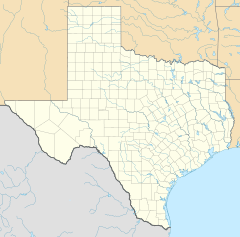Lyndon B. Johnson State Park and Historic Site facts for kids
Quick facts for kids Lyndon B. Johnson State Park and Historic Site |
|
|---|---|

Lyndon B. Johnson State Park and Historic Site
|
|
| Location | Gillespie County, Texas |
| Nearest city | Stonewall |
| Area | 732.75 acres (297 ha) |
| Established | 1965 |
| Governing body | Texas Parks and Wildlife Department |
The Lyndon B. Johnson State Park and Historic Site is a special place in Gillespie County, Texas. It sits along the Pedernales River, between Johnson City and Fredericksburg. This park was created to honor Lyndon B. Johnson, who was a former President of the United States.
The state park opened in 1970. It helps people learn about President Johnson's life and the history of the area. The Texas Parks and Wildlife Department takes care of the park.
Contents
History of the Park
Friends of President Johnson helped buy the land for this park. They donated it to the State of Texas in 1965. The park is located right across the river from Johnson's own ranch.
An architect named J. Roy White designed the park. He was a friend of the Johnson family. The park officially opened in August 1970. It started with about 269 acres (109 hectares). Over time, it grew to cover about 732 acres (296 hectares).
What You Can Do at the Park
The park has a big visitor center. Inside, you can find an interpretive center. This center teaches you all about President Johnson's life and his time as president.
You can also take tours of the nearby Lyndon B. Johnson National Historical Park. These tours start from the state park's visitor center. They are self-guided driving tours.
Fun Activities and Animals
There are many fun things to do at the park! You can go swimming, play tennis, or enjoy a game of baseball. If you like fishing, you can cast a line in the Pedernales River. There is also a nature trail perfect for hiking.
The park is home to some amazing animals. You can see small herds of Texas Longhorn cattle. These cattle are famous for their huge horns. The park also has American bison, which are large, powerful animals.
Sauer-Beckmann Farmstead: A Trip Back in Time
The Sauer-Beckmann Farmstead is a "living history farm" within the park. This means it shows you what farm life was like long ago. The Sauer family first lived here in the late 1800s. Later, the Beckmann family took over in the early 1900s.
At the farmstead, park interpreters dress in old-fashioned clothes. They do daily chores just like people did around 1918. They use tools and methods from that time. It's like stepping into a time machine!
Nature in the Park
The Lyndon B. Johnson State Park is full of natural beauty. It's a great place to see plants and animals.
Animals You Might See
White-tailed deer are often seen wandering through the park. Keep your eyes open, and you might spot one!
Beautiful Plants and Flowers
During spring and summer, the park bursts with colorful wildflowers. You can see bright Texas bluebonnets. These are the state flower of Texas. You might also spot cheerful Indian blankets.
Many different kinds of trees grow here too. Some common trees include southern catalpa and cedar elm. You can also find Mexican buckeye, live oak, ashe juniper, and post oak.
See also





